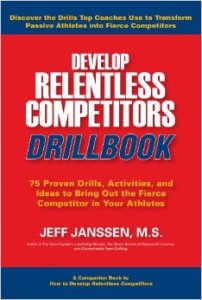Are you looking for a way to motivate your athletes to be more competitive?
Jeff Janssen has written a series of books about leadership, team building, coaching, and competitiveness. His book Develop Relentless Competitors Drillbook provides coaches with drills, concepts, activities, and stories to help them raise their athletes’ levels of competitiveness. Examples are provided in the following paragraphs. 
Concepts
Carolina Basketball’s Awards Board
In a nutshell Coach Roy Williams tracks statistics in 37 categories such as charges taken, box outs, and deflections. The categories also include turnovers, the quality of the screens, and the passes that would have been assists if the shot had not been missed. Ratios are established to measure the relationship between positive and negative plays.
These statistics did not focus on winning; rather they focused on the process of winning. Data was published shortly after each game which allowed played to have immediate feedback. As well, this allowed the coaches to recognize the players on a regular basis for their accomplishments in each of these key categories.
One of the important benefits of the awards board was that it helped players see the broader scope of the game. As well, the data provided athletes with the ability to objectively see what they needed to do to improve. The data was particularly helpful in determining the players who started and sat on the bench.
Activities
Competitiveness Continuum Discussion
Janssen has developed a continuum where players can rate themselves on the following scale of competitiveness:
• Scared
• Wimpy
• Passive
• Indifferent
• Assertive
• Aggressive
• Fierce
After rating themselves players can learn steps they can take to transition from being a scared competitor to a fierce competitor.
In addition, Janssen takes it a step further and suggests that coaches have their players evaluate their teammates on this continuum as a tool for helping them bring out the competitiveness in their teammates. Most likely, that exercise should be implemented with discretion.
Stories
The Bike Story
Stories are a great tool for helping people learn lessons they can apply to sports and life.
A young boy in Kentucky wanted a bike, but he realized his parents couldn’t afford to buy him one. He found a job at a local grocery store to earn money to buy a second-hand used bike. The boy rode it from dawn to dusk, but it was stolen after he had owned it for only a week. A few years later this young boy got involved in the sport of boxing. As a form of self-motivation, he would look at his opponent and imagine that his opponent was the person who stole his bike. This tactic seemed to work. As it turned out, Cassius Clay (Muhammed Ali), became one of the best heavyweight boxers of all-time.
Drills
You the Man
This drill is an effective way to help volleyball players learn to focus on passing and terminating the ball. The coach designates a terminator for both teams. The only time they earn a point is when that person ends the point. Each team must focus on getting good passes so their setter can effectively set the designated terminator. Teams are trying to make it difficult for their opponents to get good passes. As well, they may utilize special defenses, such as double or triple blocks, to prevent the opponents from terminating. Varying scoring systems can be used.
Even though coaches and players have a variety of tools and techniques for encouraging their teammates to get fired up, they will find Janssen’s book to be a quick read that may provide them with some new ideas for becoming relentless competitors.



 organizing. They have winning records because they recruit more players with A-level talent than other coaches and they do a better job motivating them and keeping them happy.
organizing. They have winning records because they recruit more players with A-level talent than other coaches and they do a better job motivating them and keeping them happy.